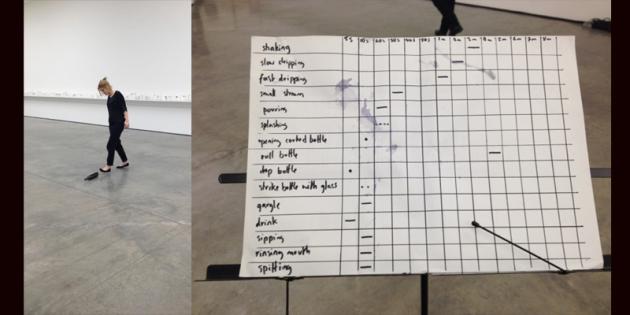Entering White Cube to view the Christian Marclay exhibition, which explores relationships between visual art and sound, you are confronted with a cacophony of noise and images. A new video installation Pub Crawl (2014) lines the wide entrance corridor. At floor level, feet on pavements kick break crush drink containers. From champagne bottles to coca-cola cans, these objects are nudged pushed dropped tapped spilling their contents and creating a symphony of sound. It is a mesmerizing installation. The galleries to the left contain Marclay’s paintings and to the right The Vinyl Factory Press, an hydraulic vinyl pressing machine created by The Vinyl Factory, which will be used throughout the exhibition to produce vinyl records.
Further down in South Gallery Two an installation of bottles on shelves flank the room and provide a backdrop for performances by the London Sinfonietta at weekends and by students and graduates of the Royal College of Art, London and London College of Communication during the week. On a lowly Thursday lunchtime Hannah Kemp-Welch was performing her variation of George Maciunas’ Duet for Full Bottle and Wine Glass from The Fluxus Performance Workbook. In a quite minimal performance, dressed in black, she manipulates water and drinks between five containers. The sounds gradually become stronger from slow dripping water into a glass to pushing an empty bottle around the concrete floor with her foot. The sound decreases again dying away to nothing as she spits the liquid onto the floor.
Spitting in public is often labeled anti-social, anti-establishment and suggestive of contempt but Hannah’s detached demeanor and measured rhythms imparted a strange elegance to these activities. Although initially uneasy about performing an anti-institution anti-materialist piece in such an environment the irony of the situation appealed to her: ‘Spitting at White Cube seemed to provide the right amount of hilarity to the proceedings, and I decided that George Maciunas would have approved after all.’ This quiet performance would have benefited from closed doors. The film sound tracks from the corridor were occasionally obtrusive but the lack of amplifiers gave the whole performance a certain simplicity which was in tune with the origins of the piece and the lo-tech approach.

Apart from the excitement of seeing Richard Diebenkorn’s wonderful work finally in the UK the other obvious plus in this exhibition are the number of works which have been retrieved from private collections and which are not normally seen in public galleries. The show starts with the Paintings from the Alberquerque series, the blistering heat of the colours pulsing off the canvas. The Urbana works are, like the Alberquerque and Berkeley paintings essentially abstract but bear a clear relationship to figuration in their suggested landscapes, urban spaces and hints of figures. The Urbana paintings have moved away from the lyricism of the earlier work, something that is recaptured in the beautiful Ocean Park Series. Already, as in Urbana #6, they contain Diebenkorn’s signature smudged submerged forms lurking beneath the surface.
Despite having forged an extremely successful career as an abstract painter, Diebenkorn moved back to figuration and his figure drawings demonstrate his consummate skill as well as a wonderful freedom of mark making in the description of figures. But here in this selection of the figurative work there are again hints of what is to come. There seems a clear compositional link between the Sea Wall and the very contemplative Invented Landscape and the Ocean Park series comprising over 150 works although only a small number are on show here. They introduce themselves by way of the wonderfully taut and satisfying cigar box lids. Intense and layered, Cigar Box Lid #4 1976 has a pale ground painted over and built up with yellow and turquoise thin rectangles carving up the space. They lose nothing in the tiny format, they pack a punch.
So from tiny cigar box lids to large canvases you can almost feel Diebenkorn’s progress as he moves backwards and forwards deliberating, placing rectangles bands lines of colour reconsidering, there is a rhythm of planning and changing. They are reserved, subtle, painterly, not overtly gestural, but the handling of paint is loose. There are bunch of small works with collage another offering from a Private Collection, acrylic, gouache pasted paper and graphite on paper. Such a good opportunity to see how he used these media to explore form and composition. They are accompanied by a lovely powerful charcoal line drawing with the lines rubbed back, combining ruled and free curved marks moving and flowing.
Ocean Park #27 1970 one of his early works in this series has a strongly divided composition and distinct colours but he moved quickly and by the following year Ocean Park 43 has a freer pale central area but still the strong turquoise, greens, blue and pink at the sides. Strong colours are continued in the intense blues with a thin band of yellow at the top of Ocean Park #116 1979. As the years go by the colours seem to mellow until by 1985 Ocean Park #130 is pale but continues the scribbled free use of paint within a structure and the use of drawn and rules lines of charcoal dividing up the space. This is a gem of an exhibition, not to be missed and to be revisited numerous times. I went first thing in the morning and the gallery was almost empty, perfect for viewing these sumptuous huge seductive canvases.
Words: Fiona Robinson © 2015 Photos Top: Fiona Robinson/Middle: Artlyst all rights reserved

